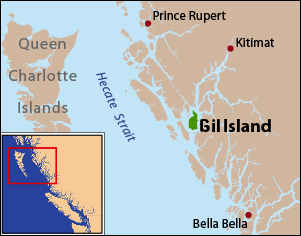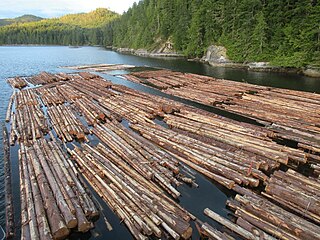
Gil Island is an island on the North Coast of British Columbia, Canada, located on the west side of Whale Channel in the entrance to Douglas Channel, one of the main coastal inlets, on the route of the Inside Passage between Pitt Island and Princess Royal Island. It is 26 km (16 mi) long, with a width ranging from 6 to 13 km, and an area of 231 km2. The only named summit on the mountainous island is Mount Gil, which faces the opening of Douglas Channel.

The Gwa'Sala-Nakwaxda'xw Nations are a union of two Kwakwaka'wakw peoples in a band government based on northern Vancouver Island in British Columbia, Canada, whose main reserve community is near the town of Port Hardy in the Queen Charlotte Strait region of the Central Coast region of British Columbia, Canada. The band government is a member of the Kwakiutl District Council and, for treaty negotiation purposes, the Winalagalis Treaty Group which includes three other members of the Kwakiutl District Council.

The Franklin Range is a small mountain range on Vancouver Island, British Columbia, Canada, located just southwest of Robson Bight and Johnstone Strait. It has an area of 200 km2 and is a subrange of the Vancouver Island Ranges which in turn form part of the Insular Mountains. The range was named in 1861 by Captain Richards for noted Arctic explorer Rear Admiral Sir John Franklin who died exploring the Arctic and his wife, Lady Franklin. The Cracroft Islands across Johnstone Strait were named for Sophia Cracroft, Sir John's niece who accompanied Lady Franklin on her journey around the world that brought them to British Columbia during the Fraser Gold Rush of 1858.
Robson Bight is a small Vancouver Island bay at the west end of Johnstone Strait across from West Cracroft Island in British Columbia, Canada that includes a protected killer whale habitat famous for its whale-rubbing beaches. The bight is adjacent to Lower Tsitika River Provincial Park. The nearest access point is Telegraph Cove on the east coast of Northern Vancouver Island.
The Tlowitsis Nation, formerly the Klowitsis Tribe, the Turnour Island Band and the Tlowitsis-Mumtagila First Nation, is the Indian Act band government of the Ławit'sis (Tlowitsis) tribe of the Kwakwaka'wakw peoples, located in the Queen Charlotte Strait-Johnstone Strait area in the Discovery Islands between Vancouver Island and the British Columbia mainland in Canada. Ławit'sis territory covers parts of northern Vancouver Island, Johnstone Strait, and adjoining inlets of the mainland. Kalugwis, on Turnour Island, was their principal community in times past, but the band's offices are in the city of Campbell River to the southeast. Hanatsa IR No. 6 on Port Neville is the most populated of the band's Indian reserves.
Havannah Channel is a marine passageway in the South Coast region of British Columbia, Canada, leading off of the north side of Johnstone Strait leading to Chatham Channel and Call Inlet, south of East Cracroft Island. Havannah Channel is entered from Johnstone Strait at the Broken Islands. Hull Island is located in the channel, to the southeast of East Cracroft and south of the opening of Call Inlet.

Minstrel Island, is an island in the Johnstone Strait region of the Central Coast region of British Columbia, Canada. It is near the entrance to Knight Inlet just east of Turnour Island at the junction of Clio and Chatham Channels. The island is separated on its south from East Cracroft Island by a marine passageway called The Blow Hole.
Hanson Island is an island in the Queen Charlotte Strait region of the Central Coast of British Columbia, located west of Harbledown Island and south of the Plumper Islands. The westernmost part of Johnstone Strait is to the south of the island, Blackfish Sound to the north, beyond which is Swanson Island. The island is named for James Hanson who served aboard HMS Chatham in 1792 and was later transferred that year to command Vancouver's supply ship HMS Daedalus.
Harbledown Island is an island in the Central Coast region of British Columbia, Canada, located west of West Cracroft Island. It is at the west end of Johnstone Strait and lies at the eastern edge of the Queen Charlotte Strait region. Hanson Island is to its west, West Cracroft Island to the south and southeast, across Baronet Passage, and Turnour Island to the northwest, across Beware Passage.

Port Neville is a bay, port and locality on the north side of Johnstone Strait, south of Call Inlet, in the Central Coast region of British Columbia, Canada.
Matilpi is a locality on the Central Coast of British Columbia, Canada, located northeast of Hull Island on the east side of Havannah Channel.

Turnour Island is an island in the Johnstone Strait region of the Central Coast of British Columbia, located between Gilford Island and West Cracroft Island. On the other side Canoe Passage on its northwest is Village Island, while to its south and southwest is Beware Passage, across from which is Harbledown Island. Gilford Island is to the north across Tribune Channel. Separating Turnour from West Cracroft is Clio Channel.
West Cracroft Island is an island in the Johnstone Strait region of the Central Coast of British Columbia, Canada, located east of Port McNeill. It is the larger of the two Cracroft Islands, the other, East Cracroft Island, being so named to distinguish between the two islands, which at low tide are one island.

Port Harvey is a port on the south side of the Cracroft Islands in the Johnstone Strait region of the Central Coast region of British Columbia, Canada, forming a small bay or inlet south of the shallows that link West Cracroft and East Cracroft Islands. On its east shore is Keecekiltum Indian Reserve No. 2, 11.7 ha., which is under the governance of the Tlowitsis Nation of the Kwakwaka'wakw peoples. at 50°33′00″N126°16′00″W. It was named by Captain Richards for Captain Harvey of HMS Havannah.
Call Inlet is an inlet on the Central Coast region of British Columbia, Canada, located south of the lower reaches of Knight Inlet to the east of East Cracroft Island. Pawala Indian Reserve No. 5 is at the head of the inlet. Chatham Channel connects the outlet of the inlet to Knight Inlet and separates East Cracroft Island from the mainland peninsula on the north side of the inlet. Havannah Channel leads southwest out of the inlet, south and east around East Cracroft and past Hull Island, to Johnstone Strait.
The Blow Hole is a short marine passage or strait separating Minstrel Island on the north from East Cracroft Island to the south, in the lower Knight Inlet region of the Central Coast region of British Columbia, Canada. At its east end is the northern end of Chatham Channel, which separates East Cracroft from the mainland to the east, and leads southeast to the opening of Call Inlet and beyond to Johnstone Strait via Havannah Passage.
Chatham Channel is a strait and marine passageway on the coast of British Columbia. It leads from the lower reaches of Knight Inlet to the opening of Call Inlet, separating Minstrel and East Cracroft Islands from the mainland to the east. From the opening of Call Inlet, running south then east around East Cracroft, is Havannah Channel.
Hull Island is an island in the Central Coast region of British Columbia, Canada, located in Havannah Channel to the east of the southern end of East Cracroft Island.
Cracroft is a locality at the east end of Forward Bay on the south side of West Cracroft Island in the Johnstone Strait region of the Central Coast of British Columbia, Canada.
Drury inlet is an inlet in the Queen Charlotte Strait region of the Central Coast of British Columbia, Canada, extending west from Wells Passage to the northwest of North Broughton Island, northwest of the town of Port Hardy. Branching off to the northeast from the north side of the head of the inlet is Actaeon Sound.






